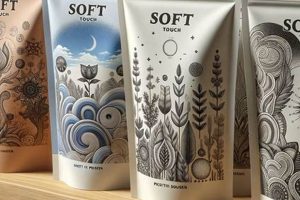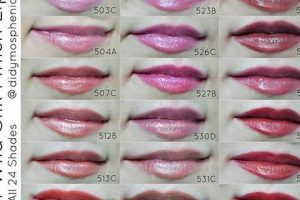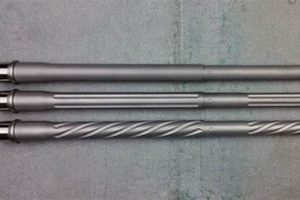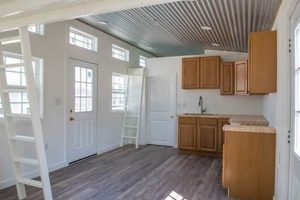A protective coating applied to the surface of a dining room table is designed to enhance its appearance and safeguard the underlying material. Examples include lacquer, varnish, polyurethane, oil, and wax, each offering distinct properties and levels of protection.
The selection of an appropriate surface treatment is crucial for preserving the longevity and aesthetic appeal of the furniture. It shields the table from daily wear and tear, including scratches, spills, and heat damage. Historically, these treatments have evolved from natural oils and waxes to more durable synthetic options, reflecting advancements in material science and manufacturing.
This exposition will explore various treatment types in detail, discussing their respective characteristics, application methods, maintenance requirements, and suitability for different wood types and dining room environments.
Selecting and Maintaining a Dining Room Table Coating
Optimizing the lifespan and appearance of a dining room table necessitates careful consideration of the surface application. The following guidelines offer insights into proper selection and maintenance practices.
Tip 1: Assess Usage Intensity: Evaluate the frequency and type of use the table will endure. High-traffic areas or homes with young children may benefit from more durable coatings like polyurethane.
Tip 2: Understand Material Compatibility: Different wood types react differently to various applications. Conduct a test application on an inconspicuous area before full application to ensure compatibility and desired aesthetic outcomes.
Tip 3: Consider Environmental Factors: Exposure to direct sunlight or extreme temperature fluctuations can impact the integrity of the covering. UV-resistant formulations can mitigate sun damage, while maintaining a stable room climate can prevent cracking or warping.
Tip 4: Implement Regular Cleaning Protocols: Use appropriate cleaning agents recommended for the specific layer type. Avoid abrasive cleaners or excessive moisture, as these can degrade the protective properties.
Tip 5: Address Scratches and Damage Promptly: Minor imperfections should be addressed immediately using touch-up kits or professional repair services to prevent further deterioration of the underlying wood.
Tip 6: Reapplication as Needed: Over time, the integrity of any protection layer will degrade. Periodic reapplication, following manufacturer guidelines, is essential for maintaining optimal protection and aesthetic appeal.
Tip 7: Consult Professional Expertise: For valuable or antique tables, engaging a professional refinisher ensures proper application and avoids irreversible damage.
Adhering to these recommendations ensures the dining room table remains a functional and aesthetically pleasing element of the home for years to come, preserving both its structural integrity and visual appeal.
The following sections will delve into specific types and their applications in greater detail, providing a comprehensive guide to optimizing the longevity and beauty of the dining room centerpiece.
1. Durability and Protection
The inherent connection between surface treatment and the safeguarding of a dining room table is fundamental. Durability, in this context, refers to the coating’s capacity to withstand physical stresses, chemical exposure, and environmental factors without degradation. Protection encompasses its ability to shield the underlying wood from damage caused by spills, scratches, heat, and ultraviolet radiation. The selection of an appropriate finish directly influences the table’s resistance to these elements, thereby determining its long-term viability and aesthetic preservation.
Consider the case of a polyurethane coating versus a traditional oil finish. Polyurethane forms a hard, impermeable barrier, providing superior resistance to scratches, water rings, and chemical stains. This makes it a practical choice for households with heavy use or where spills are common. Conversely, oil treatments penetrate the wood, offering a more natural appearance but significantly less surface protection. While oil can be reapplied to address minor blemishes, it necessitates more frequent maintenance and is less effective against significant damage. A failure to select a finish aligned with anticipated usage patterns invariably leads to accelerated wear and tear, necessitating premature repair or replacement. For instance, a lacquer application on a family table used daily may develop cracks and chips, diminishing its aesthetic and functional value.
In summary, prioritizing durability and protection in the selection process directly correlates with the extended lifespan and sustained appearance of the dining room table. The choice of finish is not merely an aesthetic consideration but a practical investment in the furniture’s long-term resilience. Ignoring this connection often results in increased maintenance costs, diminished aesthetic appeal, and ultimately, a reduced lifespan for the table. The understanding of this relationship informs responsible purchasing and care decisions, ensuring the dining room centerpiece remains a functional and visually pleasing element of the home.
2. Aesthetic Enhancement
Aesthetic enhancement constitutes a significant facet of the dining room table surface application. The chosen coating directly impacts the visual appeal, influencing the wood’s color, grain definition, and overall texture. The selection of a coating is not solely a protective measure; it is a deliberate decision to accentuate or modify the intrinsic qualities of the wood. For example, a clear, matte lacquer preserves the wood’s natural appearance, showcasing its grain and color variations. Conversely, a stain alters the wood’s tone, introducing richer hues or achieving a more uniform appearance. The application of a glossy varnish can amplify the wood’s luster, creating a formal and reflective surface. The interplay between the surface application and the wood’s natural characteristics dictates the final aesthetic outcome.
Consider the practical implications of aesthetic choices. In a modern dining room, a light-colored, wire-brushed application on oak can create a minimalist and contemporary look, enhancing the room’s overall design. In a traditional setting, a dark mahogany stain with a high-gloss polish on cherry wood can evoke a sense of elegance and formality. Incorrect selection can lead to visual disharmony. A poorly chosen stain can obscure the wood’s grain, rendering it lifeless and artificial. An inappropriate gloss level can clash with the room’s lighting, creating distracting reflections or a dated appearance. The aesthetic considerations are therefore pivotal to integrating the dining room table seamlessly into the broader design scheme.
In conclusion, the aesthetic enhancement afforded by surface treatment is an indispensable aspect of dining room table design. The correct choice of coating can amplify the wood’s inherent beauty, complement the room’s design, and create a visually appealing focal point. Conversely, an ill-considered selection can detract from the table’s natural appeal and disrupt the harmony of the dining room. Therefore, the aesthetic considerations of the surface application are as critical as its protective function in preserving and enhancing the dining room table’s overall value.
3. Application Methods
The process of applying a surface treatment to a dining room table significantly impacts the final appearance, durability, and longevity of the protective layer. Varied techniques exist, each influencing the evenness, thickness, and adhesion of the covering to the underlying wood. The selection of a specific application method is contingent upon factors such as the type of protective substance, the size and complexity of the table, and the desired aesthetic outcome.
- Brushing
Brushing involves the manual application of the coating using a brush. This technique allows for precise control, making it suitable for intricate details and smaller surfaces. However, brushing can result in visible brush strokes, particularly with thicker finishes. The quality of the brush is paramount, as loose bristles can become embedded in the surface. This method is often employed for applying varnish or oil-based treatments where a smooth, even layer is not as critical as precise application.
- Spraying
Spraying utilizes compressed air or a spray gun to atomize the surface substance and apply it evenly across the table. This method is efficient for large surfaces and achieves a uniform, streak-free appearance. However, spraying requires a controlled environment to prevent overspray and dust contamination. Furthermore, it often necessitates multiple thin coats to build up sufficient protection. Lacquer and polyurethane are frequently applied using this technique due to their ability to level and create a smooth finish.
- Wiping
Wiping involves applying the substance liberally to the surface and then wiping off the excess with a clean cloth. This technique is commonly used for oil-based treatments and stains, allowing the material to penetrate the wood’s pores while removing any surface residue. Wiping enhances the wood’s natural grain and provides a subtle, even coloration. Multiple applications may be necessary to achieve the desired depth of color and protection.
- Rolling
Rolling, while less common for intricate dining room tables, is sometimes used for large, flat surfaces. This method employs a roller to apply the protective substances, providing a relatively quick and even coating. However, rolling can introduce air bubbles and a textured finish, which may not be desirable for a smooth, refined appearance. The roller’s nap should be selected carefully to avoid leaving unwanted patterns on the surface.
The effectiveness of any application method hinges on proper surface preparation, including sanding and cleaning the wood to remove imperfections and contaminants. Regardless of the technique chosen, adherence to manufacturer guidelines and appropriate safety precautions are essential to achieve a durable, aesthetically pleasing, and long-lasting for the dining room table.
4. Maintenance Requirements
The longevity and aesthetic appeal of a dining room table are intrinsically linked to the maintenance protocols implemented. The chosen surface application dictates the specific maintenance procedures necessary to preserve the finish’s integrity and prevent premature degradation. Inadequate or inappropriate maintenance can negate the benefits of even the most durable application, leading to irreversible damage.
- Cleaning Protocols
Appropriate cleaning is essential for removing surface contaminants without compromising the protective layer. The selection of cleaning agents must align with the finish type. Abrasive cleaners can scratch polyurethane and lacquer, while excessive moisture can damage oil and wax finishes. Daily dusting with a soft cloth prevents the accumulation of particulate matter that can cause micro-scratches. For instance, a table with a varnish covering requires gentle cleaning with a pH-neutral soap and water solution, followed by thorough drying.
- Spill Management
Prompt and appropriate spill management is crucial to prevent staining and damage to the underlying wood. Absorbent materials should be used immediately to soak up liquids, followed by cleaning with a suitable cleaning agent. Acidic substances, such as wine or vinegar, can etch certain finishes if left unattended. A table with an oil-based finish requires immediate wiping and potential reapplication of oil to maintain its protective properties.
- Scratch and Damage Repair
Timely repair of scratches and minor damage prevents further deterioration of the protective layer and underlying wood. Touch-up kits specifically designed for the finish type can be used to conceal minor imperfections. Deeper scratches may require professional refinishing to restore the surface to its original condition. Ignoring scratches can lead to moisture penetration and wood rot, especially in areas with high humidity.
- Environmental Control
Maintaining a stable environment is vital for preventing expansion, contraction, and cracking of the finish. Extreme temperature fluctuations and humidity levels can compromise the integrity of the protective coating. Direct sunlight can cause fading and discoloration, particularly in darker stains. The strategic placement of the dining room table away from direct sunlight and heating vents can mitigate these risks.
These interconnected maintenance requirements collectively determine the lifespan and appearance of the dining room table. By adhering to appropriate cleaning, spill management, repair, and environmental control protocols, the integrity of the surface application is preserved, ensuring the table remains a functional and aesthetically pleasing element of the home for years to come. A failure to address any of these aspects can result in accelerated wear and tear, necessitating costly repairs or premature replacement.
5. Wood Compatibility
The selection of a dining room table’s surface application hinges critically on the compatibility between the chosen coating and the wood species used in the table’s construction. Incompatibility manifests in various forms, ranging from aesthetic anomalies to compromised structural integrity. The inherent properties of different woods, such as density, porosity, and resin content, dictate how effectively a protective covering will adhere, penetrate, and perform over time. Ignoring these material characteristics invariably leads to unsatisfactory results, necessitating costly repairs or complete refinishing.
For instance, applying an oil-based surface treatment to a dense, non-porous wood like maple can result in poor absorption and a perpetually tacky surface. Conversely, using a water-based finish on a resinous wood like pine can lead to blotching and uneven coloration as the resin interferes with the even distribution of the stain or protective covering. Similarly, the tannins present in oak wood can react adversely with certain types of coverings, causing discoloration or a breakdown of the covering’s protective properties. Practical application demands a thorough understanding of the wood’s characteristics and the covering’s chemical composition to ensure optimal adhesion, color consistency, and long-term durability. Choosing a suitable covering not only enhances the wood’s natural beauty but also provides robust protection against scratches, spills, and environmental factors.
In summary, the connection between wood compatibility and the selection of a surface application is paramount for the successful preservation and enhancement of a dining room table. A failure to account for the specific properties of the wood species can result in aesthetic flaws, compromised structural integrity, and a reduced lifespan for the furniture. Careful consideration of this critical factor ensures that the chosen covering effectively protects and enhances the wood, contributing to the table’s lasting beauty and functionality.
6. Longevity Extension
The selection and maintenance of a dining room table’s surface finish are critical determinants of its lifespan. Appropriate coating choices and consistent care practices directly contribute to extending the period during which the table remains both functional and aesthetically pleasing.
- Material Selection for Resistance
The choice of coating significantly impacts the table’s resistance to common forms of damage. For example, a polyurethane finish offers superior protection against scratches and spills compared to traditional wax applications. The former extends the table’s lifespan by minimizing surface wear, while the latter necessitates more frequent maintenance and offers less robust protection.
- Preventative Maintenance Regimens
Consistent and appropriate maintenance protocols are essential for preserving the integrity of the surface finish. Routine cleaning with non-abrasive agents prevents the accumulation of particulate matter that can cause micro-scratches. For instance, regularly dusting a table with a lacquer finish minimizes the potential for surface abrasion, thereby extending the coating’s lifespan and preserving its visual appeal.
- Environmental Considerations
The environment in which the dining room table is placed influences the longevity of its finish. Exposure to direct sunlight can cause fading and discoloration, particularly in darker stains. Similarly, fluctuations in humidity can lead to cracking and warping of the protective layer. Mitigating these environmental factors through strategic placement and climate control contributes to the finish’s durability and extends the table’s overall lifespan.
- Timely Damage Mitigation
Prompt repair of scratches, dents, or water damage is crucial for preventing further deterioration of the finish and underlying wood. Small imperfections can be addressed with touch-up kits, while more extensive damage may require professional refinishing. Addressing issues proactively prevents moisture penetration and subsequent wood rot, thereby extending the table’s structural integrity and lifespan.
These facets, when considered collectively, underscore the direct correlation between surface treatments and the extension of a dining room table’s lifespan. By prioritizing appropriate material selection, implementing consistent maintenance practices, mitigating environmental factors, and addressing damage promptly, the longevity and aesthetic appeal of the table can be significantly prolonged. These efforts represent a practical investment in the furniture’s long-term value and functionality.
Frequently Asked Questions
This section addresses common inquiries regarding the selection, maintenance, and performance of coatings applied to dining room tables. The information provided aims to clarify misconceptions and offer practical guidance for preserving the integrity of these surfaces.
Question 1: How does one determine the appropriate type of surface application for a dining room table?
The selection process should consider factors such as the table’s intended use, the wood species, and the desired aesthetic. High-traffic tables benefit from durable coatings like polyurethane, while tables with intricate detailing may require hand-applied finishes like varnish.
Question 2: What are the signs that a dining room table finish needs to be reapplied or repaired?
Indicators include visible scratches, discoloration, cloudiness, and a loss of sheen. These imperfections signal a compromised protective layer and necessitate prompt action to prevent further damage to the underlying wood.
Question 3: How frequently should a dining room table finish be cleaned, and what cleaning agents are recommended?
Daily dusting is advisable to remove particulate matter. Routine cleaning should occur weekly or as needed, using pH-neutral cleaning solutions specifically designed for the coating type. Abrasive cleaners should be avoided to prevent scratching and degradation.
Question 4: Can heat damage be repaired on a dining room table finish, and what preventative measures can be taken?
Minor heat damage may be repairable with specialized products, but severe damage typically requires professional refinishing. Preventative measures include using heat-resistant mats and coasters to protect the surface from hot dishes and beverages.
Question 5: What is the difference between oil-based and water-based coatings for dining room tables, and which is preferable?
Oil-based finishes generally offer greater durability and resistance to water damage, while water-based finishes are low in volatile organic compounds (VOCs) and dry more quickly. The preferable choice depends on individual priorities, such as durability versus environmental concerns.
Question 6: How does humidity affect the longevity of a dining room table finish, and what steps can be taken to mitigate these effects?
High humidity can cause expansion and contraction of the wood, leading to cracking and peeling of the protective layer. Maintaining stable humidity levels through climate control measures can help preserve the finish’s integrity.
These FAQs provide a foundation for understanding the nuances of dining room table finishes. Implementing these guidelines will aid in preserving the aesthetic and functional value of dining room furniture.
The following section will delve into advanced techniques for refinishing and restoring aged or damaged coatings, offering practical insights for homeowners seeking to revitalize their dining room tables.
Conclusion
The preceding exploration has detailed the multifaceted considerations inherent in selecting, applying, and maintaining a dining room table finish. Key factors, including durability, aesthetic enhancement, appropriate application methods, consistent maintenance, and wood compatibility, significantly influence the longevity and visual appeal of this furniture centerpiece. Understanding these elements enables informed decisions that protect and enhance the table’s inherent qualities.
The informed application of the principles outlined here represents a direct investment in the enduring value and functionality of the dining room table. As styles and technologies evolve, a commitment to proper finish maintenance ensures that this essential piece of furniture remains a lasting testament to quality and care. Future advancements in coating technologies promise even greater durability and aesthetic options; diligent attention to the existing principles, coupled with an openness to future innovations, will ensure the continued preservation of dining room tables for generations to come.







